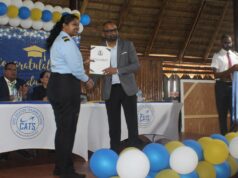By Kurt Campbell
Kurt@newsroom.gy
Over the years, work has been ongoing in Guyana to make education inclusive for children with physical disabilities, but a team of young Guyanese is shining the spotlight on other forms of learning disabilities.
While physical disability, ranging from mild to severe, can affect learning, little attention is oftentimes given to the mental setbacks of children which affect their ability to read, write, spell, understand numbers, or simply comprehend instructions.
‘Project Inclusion’ is being rolled out by a team of alumni of the U.S. State Department Youth Ambassadors Program and seeks to raise awareness about intellectual disabilities to promote diversity, equity and inclusion.
Over the weekend, over 40 teachers from Region Four were engaged in a two-day training (Feb 17 – 18) being held at the University of Guyana, Turkeyen Campus as these youngsters seek to influence a different type of transformation in the delivery of education locally, one that is void of exclusion and easily identifies and provides the support for students who suffer silently.

The News Room engaged André Ramaldo, co-project team leader, who provided greater insight on why such a project was necessary.
An educator himself, teaching at the Bishop’s High School, Ramaldo opened Saturday’s session with an icebreaker among participants which exposed that the teachers were drawn from across the nursery, primary and secondary levels and had an accumulated experience of hundreds of years in teaching. Expressions of curiosity, passion, and eagerness covered their faces as the insightful session got underway.
In an interview with the News Room, the passionate inclusive education advocate Romaldo impressed the need for much more training like this with another one already planned for March 2024 and the team intent on also visiting and engaging teachers in other regions.
“We want to help teachers to be able to know how to respond to students who have those needs and are struggling with disabilities.
“We will be focusing on dyslexia, dysgraphia, dyscalculia, learning disabilities, reading and nonverbal communication… inclusion and what an inclusive classroom looks like,” he explained.
Ramaldo was asked specifically about the reality in classrooms across Guyana currently.
His answer underscored the necessity for such a project.
“The reality? I speak from a place of knowing because I am in the classroom, many students suffer silently.
“In Guyana, we are not doing enough to raise awareness and because the awareness is low as we result we don’t know how to respond to these disabilities and are engaged in exclusion.
“Teachers have said and having read the reasons of participants, a lot of them have said they know their students are struggling but they don’t know what to do to help them,” he explained.

And so, the team hopes that while the number of teachers participating is relatively small, the sampling of teachers will return to their respective communities and schools and implement the strategies learned over the weekend.
Ramaldo said it is the expectation that the teachers will become agents for change and advocates for inclusion, creating a ripple effect that promotion inclusive education.
“The end goal is for Project Inclusion to contribute to SDG four, to ensure that children and persons altogether have access to quality education.
“Inclusion is very much necessary, we talk of an inclusive society and for us, we need to start where it all begins and that is in the classroom,” Ramaldo added.
With the project running for some time now, similar training was already completed in other regions. The project is funded by the U.S. Department of State through the Alumni Engagement Innovation Fund (AEIF).












